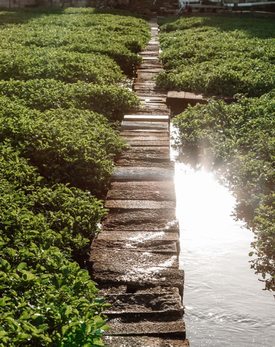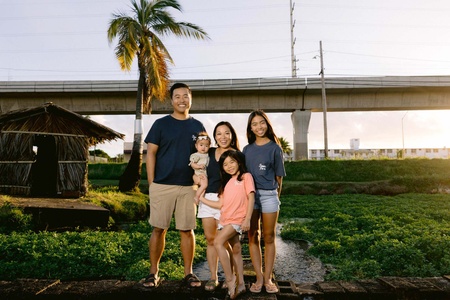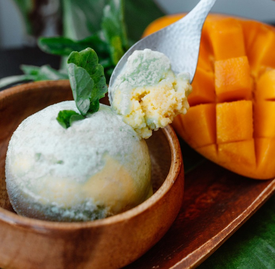LK: Can you explain the purpose of the UH ‘Ike Wai project?

ES: ‘Ike Wai was a multidisciplinary program designed to study the impact of urbanization and global warming on the islands’ freshwater sources. Our farm was used as a case study to see how our freshwater springs have been impacted by urbanization. The researchers concluded that the freshwater springs that flow through our farm are bubbling up directly from the aquifer, meaning our water is fresh and pure, not a product of runoff from upstream sources.
They also found that our water flow and crop production have declined significantly over the last two decades, with a strong decline beginning in 2015, due to hotter summers and more utilization of water from surrounding developments. Through interviews and research of old mo‘olelo (stories), they concluded that our farm is an important cultural icon for the community.Moreover, it has positive social and educational benefits that extend beyond agriculture.
LK: What are some of your fondest recollections of the farm?
ES: My childhood is filled with memories of adventures and fun I had with my cousins—fishing, playing tag with the sprinklers, sleepovers where my dad would keep us up late telling farm ghost stories.
When Kyle and I got married, we had a luau celebration at the farm. We put up big white tents and my Uncle Dave performed with his former band. My Aunty Barb surprised us with colorful homing pigeons that were released at the start of the party. The birds whipped around the farm and were so vibrant against the green fields. Everyone stayed late and it is one of the last times many of my family and friends were able to gather together, so I’m very grateful we were able to have that special memory together.
But truly, my favorite memories have been made with our kids. They re-sparked my love of the farm when I first brought them as babies. I dipped each of our babies’ toes in the freshwater springs and saw how special it is to be able to share this unique legacy and experience with them.
LK: What do the Sumida women have in common?
ES: We share an ability to be resilient. Each generation has faced their own crisis and has been able to find a way to overcome challenges and obstacles. I have the privilege of optimism because I know their hard work, sacrifices, and resilience helped our farm persevere despite so many odds stacked against us. I believe I can overcome obstacles as well and carry on for another generation.

LK: How about three interesting facts about the farm?
ES: First, there is a vast array of fish and crayfish that live in the water. We were surprised to find huge freshwater prawns recently! Second, our longest tenured field worker will be celebrating his 30th year of service this April and he has two brothers that also work on the farm. And third, the grass shack was originally designed and built in the mid-1960s. The original shack survived two hurricanes and over 50 years, and in 2021, it was rebuilt by our farm crew.

LK: What projects are you currently working on?
ES: We are working on a lot of fun and exciting projects. We’re gearing up to launch farm merchandise on our website. We partnered with a fantastic local designer who helped us create some unique designs and we can’t wait to see how the community likes it! We also are beginning to bring back keiki school tours!
LK: Please share a special memory of your grandfather.
ES: My grandfather was a larger-than-life figure. There are so many epic stories of him—as a fisherman, a Farm Bureau president, a fighter. But by the time I was born, he was my social grandfather who loved his routine of walking to Zippy’s in the morning for coffee, then sitting in the front of our farm with a Bud Light in hand and a farm cat in his lap, and talking story with friends that would drop by the farm all day and late into the evening.
When I was 18, I brought Kyle to the farm and we went fishing with my grandpa. There was a small craft advisory on that late December day, but we went out anyway. Despite the conditions, we caught a big ono (wahoo)! My grandpa was so proud and told us we were good luck. It was my only fishing trip with my grandpa that we caught a fish and it ended up being my grandpa’s last fishing trip before he passed away.
During dinner, my grandpa repeated over and over what a lucky guy he was. He said how happy and proud he was of our whole family and how much he loved his life. It brings me peace that he lived such a good life. I am so grateful he got to meet Kyle and feel he would approve of the direction we are taking for the farm.
* * * * *
The Road Taken
This year marks the 96th anniversary of Sumida Farm. Currently, the farm is able to supply 90 percent of the watercress in Hawai‘i, which amounts to over 200 tons per year.

For Emi and Kyle, four years have passed since becoming the stewards in 2020. No longer newbies, they have secured a 25-year lease until 2045, with the option to extend an additional 10 years. It is a long-term commitment, but they feel it is the right choice.
“Managing Sumida Farm is the most fulfilling thing I’ve ever done, second to being a mom,” says Emi. “It’s an honor to be able to carry on my family legacy and ensure the ‘āina and people of the farm are cared for. For me, the most fulfilling aspect of being a steward of the farm is helping to protect this incredibly special place that feeds and nourishes so many people in Hawai‘i, and ensure it can exist for at least another generation.”
I have a feeling that Emi’s grandfather, from his vantage point, is beaming with pride at his granddaughter’s dedication to their farm and to the community.
Sumida Farm website: sumidafarm.com
© 2024 Lois Kajiwara





